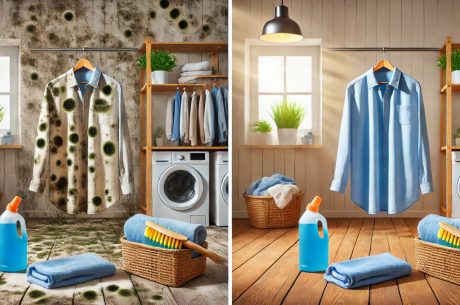Table of Contents
Flooding can cause significant damage to your home, and one of the most persistent and dangerous consequences is mold growth. Mold thrives in damp, humid environments and can begin developing within 24 to 48 hours after water exposure. Left untreated, it can lead to structural damage, health problems, and costly repairs.
Fortunately, there are steps you can take to prevent mold growth after a flood. In this guide, we’ll cover essential prevention strategies and explain why professional mold remediation is often the best solution.
Why Is Mold Dangerous?
Mold isn’t just unsightly—it can also pose serious risks:
Health hazards: Exposure to mold spores can cause respiratory issues, allergies, asthma attacks, and skin irritation.
Structural damage: Mold weakens wood, drywall, and insulation, compromising your home’s integrity.
Persistent growth: If not properly removed, mold can spread quickly and return even after cleaning.
Because of these risks, quick and effective action is crucial after a flood.
Steps to Prevent Mold Growth After a Flood
1. Remove Standing Water Immediately
The longer water sits, the higher the risk of mold. Use pumps, wet vacuums, or professional water extraction services to remove standing water as soon as possible.
2. Dry Out Affected Areas Completely
Use fans and dehumidifiers to circulate air and reduce moisture.
Open windows (if outdoor humidity is low) to improve ventilation.
Remove wet carpets, rugs, and furniture—if not dried properly, they can harbor mold.
3. Discard Unsavable Porous Materials
Porous items like:
- Carpet padding
- Mattresses
- Upholstered furniture
- Cardboard boxes
…are nearly impossible to clean thoroughly and should be discarded to prevent mold growth.
4. Clean and Disinfect All Surfaces
Use a bleach solution (1 cup bleach to 1 gallon of water) or EPA-approved antimicrobial cleaners to disinfect hard surfaces. This kills mold spores and prevents regrowth.
5. Check Hidden Areas for Moisture
Mold can grow behind walls, under floors, and in HVAC systems. Use moisture meters or infrared cameras to detect hidden dampness.
6. Monitor Humidity Levels
Keep indoor humidity below 60% (ideally 30-50%) to discourage mold. A dehumidifier can help maintain safe levels.
7. Inspect for Mold Regularly
Even after cleaning, monitor the area for musty odors, discoloration, or warping, which indicate mold growth.
When to Call a Professional Mold Remediation Service
While DIY methods can help in minor cases, professional mold remediation is often necessary after severe flooding. Here’s why:
✅ Thorough Inspection: Professionals use advanced tools to detect mold in hidden areas.
✅ Proper Containment: They prevent cross-contamination by sealing off affected zones.
✅ Safe Removal: Experts use industrial-grade cleaners and HEPA filtration to eliminate mold spores.
✅ Prevention of Recurrence: They address the root cause (moisture) to stop mold from returning.
Why Choose Our Mold Remediation Service?
At PuroClean of Auburn, we provide fast, effective, and long-lasting mold removal solutions. Our certified technicians use industry-leading techniques to ensure your home is safe and mold-free.
🔹 24/7 Emergency Response – We’re available when you need us most.
🔹 Advanced Detection & Removal – No mold is left behind.
🔹 Prevention Strategies – We help you avoid future outbreaks.
Don’t let mold take over your home—contact us today for a free inspection and quote!
Reasons Why You Need a Professional Restoration Company After a Flood
When your home suffers flood damage, time is critical. Mold can begin growing within 24-48 hours, and improper cleanup can lead to long-term structural damage and health risks. While DIY efforts may seem cost-effective, hiring a professional water damage restoration and mold remediation company is the safest, most efficient solution.
Here are five key reasons why you need experts to handle post-flood restoration:
1. Rapid Water Extraction & Drying to Prevent Mold
Standing water and lingering moisture create the perfect environment for mold. While you can use towels and fans, professional-grade equipment is far more effective:
Industrial pumps & wet vacuums remove water quickly.
High-speed air movers & commercial dehumidifiers dry structures thoroughly.
Moisture meters & thermal imaging detect hidden dampness in walls and floors.
Without professional drying, trapped moisture leads to hidden mold growth, which can spread undetected for months.
2. Proper Mold Remediation & Prevention
Bleach and store-bought cleaners only surface-clean mold—they don’t kill roots or prevent regrowth. Professional remediation includes:
HEPA vacuuming & antimicrobial treatments to eliminate spores.
Containment barriers to prevent cross-contamination.
Post-remediation testing to ensure mold is completely removed.
Attempting DIY mold removal can disturb spores, making the problem worse and risking your health.
3. Structural Integrity & Hidden Damage Assessment
Floodwater weakens building materials, leading to:
Warped floors & crumbling drywall
Rotting wood & compromised foundations
Electrical & plumbing hazards
Professionals assess hidden structural damage and recommend repairs before costly issues arise.
4. Health & Safety Protection
Floodwater often contains sewage, chemicals, and bacteria, making cleanup hazardous. A restoration company:
Follows OSHA & EPA safety protocols
Uses PPE (gloves, respirators, protective suits)
Disposes of contaminated materials properly
DIY cleanup exposes you to toxic mold, pathogens, and electrical risks.
5. Insurance Claims Assistance
Documenting damage correctly is crucial for insurance reimbursement. A restoration company:
Provides detailed damage reports & photos
Works directly with adjusters to maximize your claim
Helps prevent claim denials due to improper cleanup
Without professional documentation, you risk out-of-pocket expenses.
Final Thoughts
Preventing mold after a flood requires immediate action, thorough drying, and proper cleaning. While small-scale mold issues can sometimes be handled independently, professional remediation is the safest and most effective long-term solution.
If you’re dealing with post-flood mold, don’t wait—reach out to PuroClean of Auburn for expert mold removal and prevention services. Your health and home deserve the best protection!
📞 Call us now at (207) 531-1200 or visit our contact page to schedule an inspection.




 PuroClean of Auburn
PuroClean of Auburn